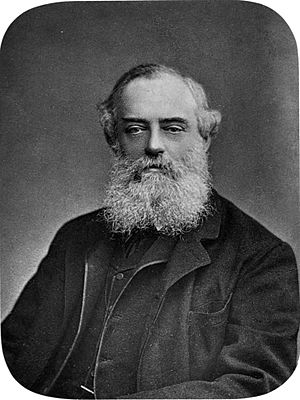William Thomas Blanford facts for kids
Quick facts for kids
William Thomas Blanford
|
|
|---|---|
 |
|
| Born | 7 October 1832 London, England
|
| Died | 23 June 1905 (aged 72) London, England
|
| Education | School of Design, Somerset House; Royal School of Mines; mining school, Freiberg, Saxony |
| Known for | The Fauna of British India, Including Ceylon and Burma |
| Spouse(s) | Ida Gertrude Bellhouse |
| Parents |
|
| Awards | Wollaston Medal (1883) Royal Medal (1901) Fellow of the Royal Society< Companion of the Order of the Indian Empire |
| Scientific career | |
| Institutions | Civitavecchia, Italy; Geological Survey of India |
| Author abbrev. (zoology) | Blanford |
William Thomas Blanford CIE FRS (October 7, 1832 – June 23, 1905) was an English scientist. He was a geologist, who studies rocks and the Earth, and a naturalist, who studies living things. He is best known for editing a huge book series called The Fauna of British India, Including Ceylon and Burma. This series described all the animals found in India, Sri Lanka, and Myanmar.
Contents
William Blanford's Life and Work
William Blanford was born in London, England. His father owned a factory. William went to private schools in Brighton and Paris. He first worked in his family's business, carving and gilding.
Early Education and Career
Because of poor health, he spent two years working in Italy. When he returned to England in 1851, he joined the new Royal School of Mines. His younger brother, Henry F. Blanford, also studied there. William learned from famous scientists of his time.
After this, he spent a year at a mining school in Germany. By the end of 1854, both William and his brother got jobs with the Geological Survey of India. William worked there for 27 years, until 1882.
Geological Discoveries in India
William Blanford worked in many parts of India. He explored coalfields in Raniganj and near Talcher. In Talcher, he made an amazing discovery. He found large rocks that looked like they had been carried by ice. This showed that glaciers might have been in that area a very long time ago.
He also studied ancient plants called Glossopteris flora. These plants are important for understanding how continents moved over time. He visited Burma to study an extinct volcano. He also looked at the Deccan Traps, which are huge layers of volcanic rock in India.
Expeditions and Natural History
In 1867, Blanford joined an expedition to Abyssinia. He wrote a book about the geology and animals he saw there. From 1871 to 1872, he was part of a group exploring the border of Persia.
During this trip, he traveled through many countries. He studied the natural history of these places. He paid attention to both geology and zoology, especially land gastropods (snails) and vertebrates (animals with backbones).
He also traveled to Sikkim with another naturalist, H. J. Elwes. Together, they found and described several new types of birds. Between 1870 and 1881, Blanford described 36 new species of reptiles and three new species of amphibians.
Later Life and Recognition
In 1883, William Blanford married Ida Gertrude Bellhouse. They settled in London. After retiring from the Geological Survey, he became the editor of The Fauna of British India, Including Ceylon and Burma series. This was a huge project to document all the animals in the region.
For his important work in geology, he received the Wollaston Medal in 1883. In 1901, he received a Royal Medal for his work on the animals and geology of British India. He was also elected a Fellow of the Royal Society, which is a great honor for scientists. He died in London in 1905 at the age of 72.
His main books include Observations on the Geology and Zoology of Abyssinia (1870) and Manual of the Geology of India (1879). He also wrote the third volume on birds for The Fauna of British India series.
Animals Named After William Blanford
Many animals have been named in honor of William Thomas Blanford. This is a way for other scientists to remember his important contributions.
Here are some of the animals named after him:
- Blanfordia A. Adams, 1863 – a type of land snail.
- Calandrella blanfordi (Shelley, 1902) – a bird called Blanford's short-toed lark.
- Bunopus blanfordii Strauch, 1887 – a type of gecko (a small lizard).
- Draco blanfordii Boulenger, 1885 – a type of flying lizard.
- Acanthodactylus blanfordii Boulenger, 1918 – another type of lizard.
- Ophiomorus blanfordii Boulenger, 1887 – a type of snake skink (a lizard that looks like a snake).
- Psammophilus blanfordanus (Stoliczka, 1871) – a type of rock agama (a lizard).
- Afrotyphlops blanfordii (Boulenger, 1889) – a type of blind snake.
- Myriopholis blanfordi (Boulenger, 1890) – a type of worm snake.
- Sphaerias blanfordi (Thomas, 1891) – a type of fruit bat.
- The English name of Vulpes cana (Blanford, 1877) is Blanford's fox.
Images for kids



